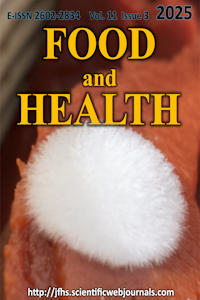Baklagil bazlı yoğurt analoglarının besinsel profili, duyusal özellikleri ve antioksidan potansiyelinin araştırılması
Abstract
Bu çalışma, nohut, acı bakla ve kuru fasulyeden elde edilen baklagil bazlı yoğurt analoglarının duyusal, makro besin ögesi, antioksidan ve fizikokimyasal özelliklerini analiz ederek fonksiyonel gıda potansiyelini araştırmakta ve hayvansal yoğurt ile karşılaştırmaktadır. Yapılan duyusal değerlendirmelerde en yüksek puan hayvansal yoğurtta, en düşük puan ise acı bakla bazlı yoğurt analoğunda gözlenmiştir. Nohut ve fasulye bazlı yoğurt analogları, duyusal açıdan acı bakla bazlı ürünlere kıyasla daha iyi kabul görmüştür (p<0.05). Fasulye bazlı yoğurt analogları hayvansal yoğurda göre yüksek protein içeriğine (sırasıyla %6.35 ±0.59 ve %3.87 ±0.21 g) sahipken (p=0.01), karbonhidrat içeriği tüm baklagil bazlı analoglarda daha yüksek bulunmuştur (p<0.001). Antioksidan analizlerde, fasulye bazlı yoğurt analoglarının en yüksek antioksidan kapasite değerine (0.91 ±0.06 mmol Trolox Eq/L) sahip olduğu; genel olarak baklagil bazlı analoglarının, antioksidan kapasite ve oksidan kapasite açısından hayvansal yoğurda kıyasla daha yüksek değerlere ulaştığı belirlenmiştir. En yüksek oksidatif stres indeksi değeri acı bakla bazlı analoglarda (0.56 ±0.02 AU, p<0.05) gözlenmiştir. Renk ölçümleri, parlaklık ve sarılıkta anlamlı farklılıklar gözlenmiş; hayvansal yoğurt daha yüksek parlaklığa, acı bakla bazlı analoglar ise daha yüksek sarılığa sahip olmuştur (p<0.001). Baklagil bazlı yoğurt analogları, özellikle fasulye ve nohuttan elde edilenler, yüksek protein içeriği ve antioksidan özellikleri sayesinde umut verici fonksiyonel gıda alternatifleri sunmaktadır. Ancak, tüketici kabulünü artırmak için duyusal ve fiziksel iyileştirmelere ihtiyaç vardır.
Ethical Statement
Bu araştırma için Bolu Abant İzzet Baysal Üniversitesi Girişimsel Olmayan Klinik Araştırmalar Etik Kurulu Onayı alınmıştır (Karar No: 2024/337).
Supporting Institution
TÜBİTAK
Project Number
1919B012323430
Thanks
The authors would like to thank the Scientific and Technological Research Council of Türkiye (TÜBİTAK) and the panelists who participated in the sensory analysis.
References
- Angelino, D., Rosi, A., Vici, G., Russo, M., Pellegrini, N., Martini, D. (2020). Nutritional quality of plant-based drinks sold in italy: the food labelling of italian products (flip) study. Foods, 9(5), 682. https://doi.org/10.3390/foods9050682
- AOAC (Association of Official Analytical Chemists). (2000). Official methods of analysis. Association of Official Analytical Chemists International, Association of Official Analytical Chemists (publisher), Washington, DC 0044, USA, pp 1018. ISBN: 0935584676
- Aydar, E.F., Tutuncu, S., Ozcelik, B. (2020). Plant-based milk substitutes: Bioactive compounds, conventional and novel processes, bioavailability studies, and health effects. Journal of Functional Foods, 70, 103975. https://doi.org/10.1016/j.jff.2020.103975
- Bader, S., Oviedo, J.P., Pickardt, C., & Eisner, P. (2011). Influence of different organic solvents on the functional and sensory properties of lupin (Lupinus angustifolius L.) proteins. LWT-Food Science and Technology, 44(6), 1396-1404. https://doi.org/10.1016/j.lwt.2011.01.007
- Bilici, R. (2022). Vegan mutfağı kapsamında geliştirilmiş yenilikçi bir ürün: Bitkisel bazlı pastacı kreması. İstanbul Gelişim Üniversitesi Lisansüstü Eğitim Enstitüsü, Yüksek Lisans Tezi.
- Craig, W., Brothers, C. (2021). Nutritional content and health profile of non-dairy plant-based yogurt alternatives. Nutrients, 13(11), 4069. https://doi.org/10.3390/nu13114069
- D’Andrea, A. (2023). A comparison of the nutritional profile and nutrient density of commercially available plant-based and dairy yogurts in the united states. Frontiers in Nutrition, 10. https://doi.org/10.3389/fnut.2023.1195045
- Dhakal, D., Younas, T., Bhusal, R. P., Devkota, L., Henry, C.J., Dhital, S. (2023). Design rules of plant-based yoghurt-mimic: Formulation, functionality, sensory profile and nutritional value. Food Hydrocolloids, 142, 108786. https://doi.org/10.1016/j.foodhyd.2023.108786
- Diez-Ozaeta, I., Vázquez-Araújo, L., Estrada, O., Puente, T., Regefalk, J. (2024). Exploring the Role of Lactic Acid Bacteria Blends in Shaping the Volatile Composition of Fermented Dairy and Rice-Based Beverages: A Step towards Innovative Plant-Based Alternatives. Foods, 13(5), 664. https://doi.org/10.3390/foods13050664
- Clark, S., Costello, M., Drake, M., Bodyfelt, F. (Eds.). (2009). The sensory evaluation of dairy products (Vol. 571). New York: Springer. ISBN: 978-3-031-30019-6 https://doi.org/10.1007/978-0-387-77408-4
- Farooq, K., Haque, Z.U. (1992). Effect of sugar esters on the textural properties of nonfat low calorie yogurt. Journal of Dairy Science, 75(10), 2676-2680. https://doi.org/10.3168/jds.S0022-0302(92)78029-1
- FMI (Future Market Insights). (2023). Plantbased milk market by category, by form, by product type, by flavor type, by end-use, by sales channel, by region for 2023–2033. https://www.futuremarketinsights.com/reports/ plant-based-milk-market. (Erişim Tarihi: 04.02.2025)
- Grasso, N., Alonso-Miravalles, L., O’Mahony, J. A. (2020). Composition, physicochemical and sensorial properties of commercial plant-based yogurts. Foods, 9(3), 252. https://doi.org/10.3390/foods9030252
- Greis, M., Sainio, T., Katina, K., Nolden, A.A., Kinchla, A.J., Seppä, L., Partanen, R. (2022). Physicochemical properties and mouthfeel in commercial plant-based yogurts. Foods, 11(7), 941. https://doi.org/10.3390/foods11070941
- Gupta, M.K., Torrico, D.D., Ong, L., Gras, S.L., Dunshea, F.R., Cottrell, J.J. (2022). Plant and dairy-based yogurts: a comparison of consumer sensory acceptability linked to textural analysis. Foods, 11(3), 463. https://doi.org/10.3390/foods11030463
- Helal, A. (2023). Influence of using wheatgrass juice on the nutritional value and characteristics of set yogurt. Journal of Agricultural and Environmental Sciences, 22(3), 263-285. https://doi.org/10.21608/jaesj.2024.235807.1110
- Heymann, H., Machado, B., Torri, L., & Robinson, A. L. (2012). How many judges should one use for sensory descriptive analysis?. Journal of Sensory Studies, 27(2), 111-122. https://doi.org/10.1111/j.1745-459X.2012.00373.x
- Hickisch, A., Beer, R., Vogel, R. F., Toelstede, S. (2016). Influence of lupin-based milk alternative heat treatment and exopolysaccharide-producing lactic acid bacteria on the physical characteristics of lupin-based yogurt alternatives. Food Research International, 84, 180-188. https://doi.org/10.1016/j.foodres.2016.03.037
- Laaksonen, O., Kahala, M., Marsol-Vall, A., Blasco, L., Järvenpää, E., Rosenvald, S., Yang, B. (2021). Impact of lactic acid fermentation on sensory and chemical quality of dairy analogues prepared from lupine (Lupinus angustifolius L.) seeds. Food chemistry, 346, 128852. https://doi.org/10.1016/j.foodchem.2020.128852
- Malki, M.K.S., Pamunuwa, K.M.G.K., Wijesinghe, J.A.A.C. (2022). Development and quality evaluation of oat (Avena sativa) incorporated drinking yogurt. Journal of Science, 13(2). http://doi.org/10.4038/jsc.v13i2.48
- Marlapati, L., Basha, R.F., Navarre, A., Kinchla, A.J., Nolden, A.A. (2024). Comparison of Physical and Compositional Attributes between Commercial Plant-Based and Dairy Yogurts. Foods, 13(7), 984. https://doi.org/10.3390/foods13070984
- Pandey, S., Ritz, C., Perez-Cueto, F.J.A. (2021). An application of the theory of planned behaviour to predict intention to consume plant-based yogurt alternatives. Foods, 10(1), 148. https://doi.org/10.3390/foods10010148
- Paul, A.A., Kumar, S., Kumar, V., Sharma, R. (2020). Milk Analog: Plant based alternatives to conventional milk, production, potential and health concerns. Critical reviews in food science and nutrition, 60(18), 3005-3023. https://doi.org/10.1080/10408398.2019.1674243
- Postolache, A. (2023). A clean-label formulation of fortified yogurt based on rhododendron flower powder as a functional ingredient. Foods, 12(23), 4365. https://doi.org/10.3390/foods12234365
- Pua, A., Tang, V.C.Y., Goh, R.M.V., Sun, J., Lassabliere, B., Liu, S. Q. (2022). Ingredients, processing, and fermentation: addressing the organoleptic boundaries of plant-based dairy analogues. Foods, 11(6), 875. https://doi.org/10.3390/foods11060875
- Rashwan, A.K., Osman, A.I., Chen, W. (2023). Natural nutraceuticals for enhancing yogurt properties: a review. Environmental Chemistry Letters, 21(3), 1907-1931. https://doi.org/10.1007/s10311-023-01588-0
- Runte, M., Guth, J.N., Ammann, J. (2024). Consumers’ perception of plant-based alternatives and changes over time. A linguistic analysis across three countries and ten years. Food Quality and Preference, 113, 105057. https://doi.org/10.1016/j.foodqual.2023.105057
- Silva, S., Fernandes, I., Barros, L., Fernandes, Â., Alves, M., Calhelha, R., Barreiro, M. (2019). Spray-dried spirulina platensis as an effective ingredient to improve yogurt formulations: testing different encapsulating solutions. Journal of Functional Foods, 60, 103427. https://doi.org/10.1016/j.jff.2019.103427
- Thorning, T.K., Raben, A., Tholstrup, T., Soedamah- Muthu, S.S., Givens, I., Astrup, A. (2016). Milk and dairy products: good or bad for human health? An assessment of the totality of scientific evidence. Food & nutrition research, 60(1), 32527. https://doi.org/10.3402/fnr.v60.32527
- Uçurum, M. (2017). Fuzzy statistical process control of a calcite grinding plant using total color difference parameter (ΔE). IOSR Journal of Engineering, 7, 7-22. https://doi.org/10.9790/3021-0705010722
- Wijesekara, A., Weerasingha, V., Jayarathna, S., Priyashantha, H. (2022). Quality parameters of natural phenolics and its impact on physicochemical, microbiological, and sensory quality attributes of probiotic stirred yogurt during the storage. Food Chemistry: X, 14, 100332. https://doi.org/10.1016/j.fochx.2022.100332
Investigation of nutritional profile, sensory properties and antioxidant potential of legume-based yoghurt analogues
Abstract
This study investigates the functional food potential of legume-based yoghurt analogues derived from chickpeas, lupins, and beans by analysing their sensory, macronutrient, antioxidant, and physicochemical properties, comparing them with conventional dairy yoghurt. Sensory evaluation showed that dairy yoghurt received the highest scores, while lupin-based yoghurt analogue had the lowest. Chickpea- and bean-based yoghurt analogues were better accepted than lupin-based products in terms of sensory attributes (p<0.05). Bean-based yoghurt analogue had a significantly higher protein content (6.35 ±0.59% vs. 3.87 ±0.21%, p=0.01) compared to dairy yoghurt, while all legume-based analogues exhibited higher carbohydrate content (p<0.001). Antioxidant analyses revealed that bean-based yoghurt analogues had the highest antioxidant capacity value (0.91 ±0.06 mmol Trolox Eq/L); overall, legume-based analogues exhibited higher antioxidant and oxidant capacity values compared to dairy yoghurt. However, the highest Oxidative Stress Index value was observed in lupin-based analogues (0.56 ±0.02 AU, p<0.05). Colour measurements showed significant differences in brightness and yellowness; dairy yoghurt had higher brightness, while lupin-based analogues exhibited greater yellowness (p<0.001). Legume-based yoghurt analogues, particularly those derived from beans and chickpeas, present promising functional food alternatives due to their high protein content and antioxidant properties. However, sensory and textural improvements are necessary to enhance consumer acceptance.
Ethical Statement
Bolu Abant İzzet Baysal University Non-Interventional Clinical Research Ethics Committee Approval was received for this research (Decision No: 2024/337).
Supporting Institution
TÜBİTAK
Project Number
1919B012323430
References
- Angelino, D., Rosi, A., Vici, G., Russo, M., Pellegrini, N., Martini, D. (2020). Nutritional quality of plant-based drinks sold in italy: the food labelling of italian products (flip) study. Foods, 9(5), 682. https://doi.org/10.3390/foods9050682
- AOAC (Association of Official Analytical Chemists). (2000). Official methods of analysis. Association of Official Analytical Chemists International, Association of Official Analytical Chemists (publisher), Washington, DC 0044, USA, pp 1018. ISBN: 0935584676
- Aydar, E.F., Tutuncu, S., Ozcelik, B. (2020). Plant-based milk substitutes: Bioactive compounds, conventional and novel processes, bioavailability studies, and health effects. Journal of Functional Foods, 70, 103975. https://doi.org/10.1016/j.jff.2020.103975
- Bader, S., Oviedo, J.P., Pickardt, C., & Eisner, P. (2011). Influence of different organic solvents on the functional and sensory properties of lupin (Lupinus angustifolius L.) proteins. LWT-Food Science and Technology, 44(6), 1396-1404. https://doi.org/10.1016/j.lwt.2011.01.007
- Bilici, R. (2022). Vegan mutfağı kapsamında geliştirilmiş yenilikçi bir ürün: Bitkisel bazlı pastacı kreması. İstanbul Gelişim Üniversitesi Lisansüstü Eğitim Enstitüsü, Yüksek Lisans Tezi.
- Craig, W., Brothers, C. (2021). Nutritional content and health profile of non-dairy plant-based yogurt alternatives. Nutrients, 13(11), 4069. https://doi.org/10.3390/nu13114069
- D’Andrea, A. (2023). A comparison of the nutritional profile and nutrient density of commercially available plant-based and dairy yogurts in the united states. Frontiers in Nutrition, 10. https://doi.org/10.3389/fnut.2023.1195045
- Dhakal, D., Younas, T., Bhusal, R. P., Devkota, L., Henry, C.J., Dhital, S. (2023). Design rules of plant-based yoghurt-mimic: Formulation, functionality, sensory profile and nutritional value. Food Hydrocolloids, 142, 108786. https://doi.org/10.1016/j.foodhyd.2023.108786
- Diez-Ozaeta, I., Vázquez-Araújo, L., Estrada, O., Puente, T., Regefalk, J. (2024). Exploring the Role of Lactic Acid Bacteria Blends in Shaping the Volatile Composition of Fermented Dairy and Rice-Based Beverages: A Step towards Innovative Plant-Based Alternatives. Foods, 13(5), 664. https://doi.org/10.3390/foods13050664
- Clark, S., Costello, M., Drake, M., Bodyfelt, F. (Eds.). (2009). The sensory evaluation of dairy products (Vol. 571). New York: Springer. ISBN: 978-3-031-30019-6 https://doi.org/10.1007/978-0-387-77408-4
- Farooq, K., Haque, Z.U. (1992). Effect of sugar esters on the textural properties of nonfat low calorie yogurt. Journal of Dairy Science, 75(10), 2676-2680. https://doi.org/10.3168/jds.S0022-0302(92)78029-1
- FMI (Future Market Insights). (2023). Plantbased milk market by category, by form, by product type, by flavor type, by end-use, by sales channel, by region for 2023–2033. https://www.futuremarketinsights.com/reports/ plant-based-milk-market. (Erişim Tarihi: 04.02.2025)
- Grasso, N., Alonso-Miravalles, L., O’Mahony, J. A. (2020). Composition, physicochemical and sensorial properties of commercial plant-based yogurts. Foods, 9(3), 252. https://doi.org/10.3390/foods9030252
- Greis, M., Sainio, T., Katina, K., Nolden, A.A., Kinchla, A.J., Seppä, L., Partanen, R. (2022). Physicochemical properties and mouthfeel in commercial plant-based yogurts. Foods, 11(7), 941. https://doi.org/10.3390/foods11070941
- Gupta, M.K., Torrico, D.D., Ong, L., Gras, S.L., Dunshea, F.R., Cottrell, J.J. (2022). Plant and dairy-based yogurts: a comparison of consumer sensory acceptability linked to textural analysis. Foods, 11(3), 463. https://doi.org/10.3390/foods11030463
- Helal, A. (2023). Influence of using wheatgrass juice on the nutritional value and characteristics of set yogurt. Journal of Agricultural and Environmental Sciences, 22(3), 263-285. https://doi.org/10.21608/jaesj.2024.235807.1110
- Heymann, H., Machado, B., Torri, L., & Robinson, A. L. (2012). How many judges should one use for sensory descriptive analysis?. Journal of Sensory Studies, 27(2), 111-122. https://doi.org/10.1111/j.1745-459X.2012.00373.x
- Hickisch, A., Beer, R., Vogel, R. F., Toelstede, S. (2016). Influence of lupin-based milk alternative heat treatment and exopolysaccharide-producing lactic acid bacteria on the physical characteristics of lupin-based yogurt alternatives. Food Research International, 84, 180-188. https://doi.org/10.1016/j.foodres.2016.03.037
- Laaksonen, O., Kahala, M., Marsol-Vall, A., Blasco, L., Järvenpää, E., Rosenvald, S., Yang, B. (2021). Impact of lactic acid fermentation on sensory and chemical quality of dairy analogues prepared from lupine (Lupinus angustifolius L.) seeds. Food chemistry, 346, 128852. https://doi.org/10.1016/j.foodchem.2020.128852
- Malki, M.K.S., Pamunuwa, K.M.G.K., Wijesinghe, J.A.A.C. (2022). Development and quality evaluation of oat (Avena sativa) incorporated drinking yogurt. Journal of Science, 13(2). http://doi.org/10.4038/jsc.v13i2.48
- Marlapati, L., Basha, R.F., Navarre, A., Kinchla, A.J., Nolden, A.A. (2024). Comparison of Physical and Compositional Attributes between Commercial Plant-Based and Dairy Yogurts. Foods, 13(7), 984. https://doi.org/10.3390/foods13070984
- Pandey, S., Ritz, C., Perez-Cueto, F.J.A. (2021). An application of the theory of planned behaviour to predict intention to consume plant-based yogurt alternatives. Foods, 10(1), 148. https://doi.org/10.3390/foods10010148
- Paul, A.A., Kumar, S., Kumar, V., Sharma, R. (2020). Milk Analog: Plant based alternatives to conventional milk, production, potential and health concerns. Critical reviews in food science and nutrition, 60(18), 3005-3023. https://doi.org/10.1080/10408398.2019.1674243
- Postolache, A. (2023). A clean-label formulation of fortified yogurt based on rhododendron flower powder as a functional ingredient. Foods, 12(23), 4365. https://doi.org/10.3390/foods12234365
- Pua, A., Tang, V.C.Y., Goh, R.M.V., Sun, J., Lassabliere, B., Liu, S. Q. (2022). Ingredients, processing, and fermentation: addressing the organoleptic boundaries of plant-based dairy analogues. Foods, 11(6), 875. https://doi.org/10.3390/foods11060875
- Rashwan, A.K., Osman, A.I., Chen, W. (2023). Natural nutraceuticals for enhancing yogurt properties: a review. Environmental Chemistry Letters, 21(3), 1907-1931. https://doi.org/10.1007/s10311-023-01588-0
- Runte, M., Guth, J.N., Ammann, J. (2024). Consumers’ perception of plant-based alternatives and changes over time. A linguistic analysis across three countries and ten years. Food Quality and Preference, 113, 105057. https://doi.org/10.1016/j.foodqual.2023.105057
- Silva, S., Fernandes, I., Barros, L., Fernandes, Â., Alves, M., Calhelha, R., Barreiro, M. (2019). Spray-dried spirulina platensis as an effective ingredient to improve yogurt formulations: testing different encapsulating solutions. Journal of Functional Foods, 60, 103427. https://doi.org/10.1016/j.jff.2019.103427
- Thorning, T.K., Raben, A., Tholstrup, T., Soedamah- Muthu, S.S., Givens, I., Astrup, A. (2016). Milk and dairy products: good or bad for human health? An assessment of the totality of scientific evidence. Food & nutrition research, 60(1), 32527. https://doi.org/10.3402/fnr.v60.32527
- Uçurum, M. (2017). Fuzzy statistical process control of a calcite grinding plant using total color difference parameter (ΔE). IOSR Journal of Engineering, 7, 7-22. https://doi.org/10.9790/3021-0705010722
- Wijesekara, A., Weerasingha, V., Jayarathna, S., Priyashantha, H. (2022). Quality parameters of natural phenolics and its impact on physicochemical, microbiological, and sensory quality attributes of probiotic stirred yogurt during the storage. Food Chemistry: X, 14, 100332. https://doi.org/10.1016/j.fochx.2022.100332
Details
| Primary Language | Turkish |
|---|---|
| Subjects | Food Nutritional Balance, Public Health Nutrition, Nutrition and Dietetics (Other) |
| Journal Section | Research Article |
| Authors | |
| Project Number | 1919B012323430 |
| Early Pub Date | June 19, 2025 |
| Publication Date | July 1, 2025 |
| Submission Date | February 6, 2025 |
| Acceptance Date | April 14, 2025 |
| Published in Issue | Year 2025 Volume: 11 Issue: 3 |
Journal is licensed under a
CreativeCommons Attribtion-ShareAlike 4.0 International Licence 


Diamond Open Access refers to a scholarly publication model in which journals and platforms do not charge fees to either authors or readers.
Open Access Statement:
This is an open access journal which means that all content is freely available without charge to the user or his/her institution. Users are allowed to read, download, copy, distribute, print, search, or link to the full texts of the articles, or use them for any other lawful purpose, without asking prior permission from the publisher or the author. This is in accordance with the BOAI definition of open access.
Archiving Policy:
Archiving is done according to ULAKBİM "DergiPark" publication policy (LOCKSS).

